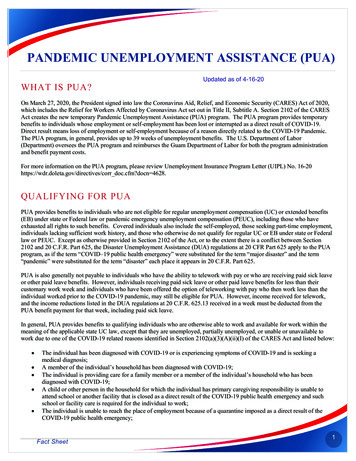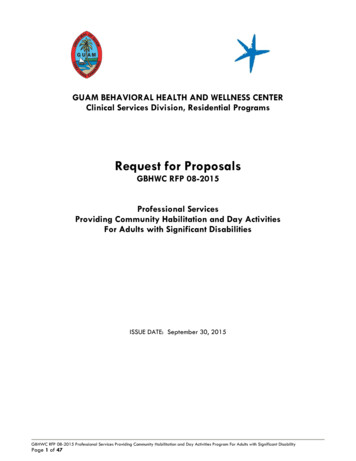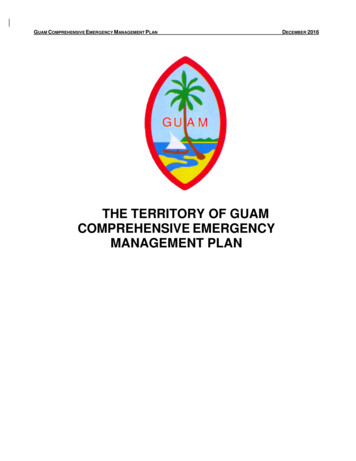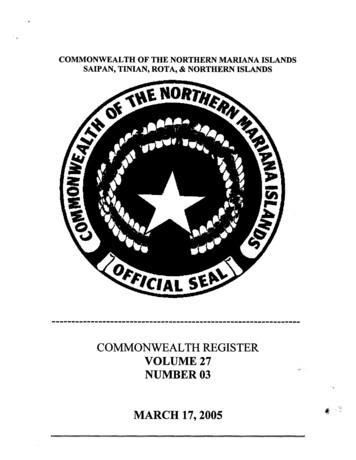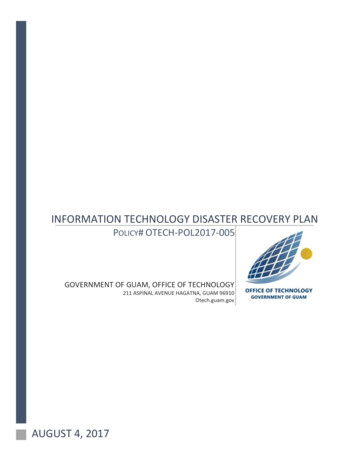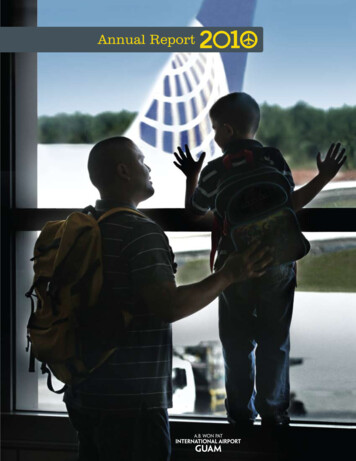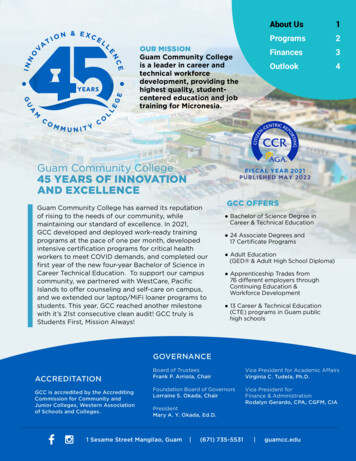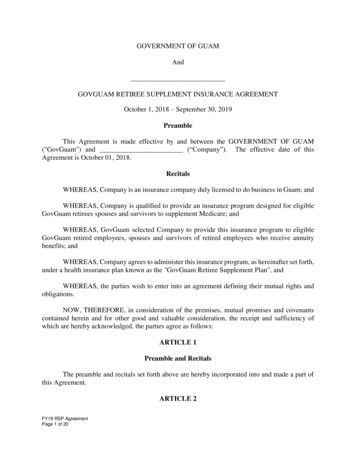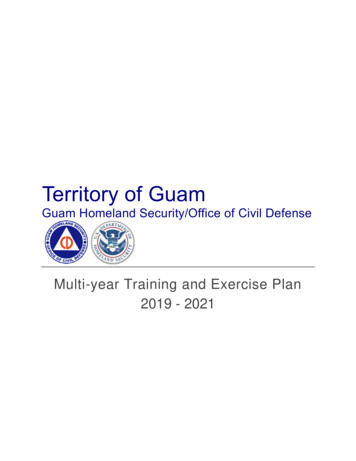
Transcription
Territory of GuamGuam Homeland Security/Office of Civil DefenseMulti-year Training and Exercise Plan2019 - 2021
PREFACEThe U.S. Department of Homeland Security (DHS) Grants Programs Directorate requireseach state and territory to conduct a Multiyear Training and Exercise Planning Workshop(TEPW) annually. The Guam Homeland Security/Office of Civil Defense (GHS/OCD)2019 – 2021 Training and Exercise Plan (T&E Plan) is a result of Guam’s 2018 TEPW,conducted August 22, 2018.The Territory’s training and exercise programs are administered by GHS/OCD Trainingand Exercise Section (T&E), in coordination with local and federal, DOD, private sectorand non-governmental organizations. The training and exercise agenda described in thisplan is binding for all levels of response for agencies receiving homeland security funding.The Guam MYTEP is the roadmap for the Territory to accomplish the priorities within thedocument. Guam is pursuing a coordinated homeland security strategy that combinesgreater planning, realistic exercises and innovative training to strengthen the Territory’semergency prevention, response and recovery to emergencies or disasters. Training andexercise activities are the foundations on improving our preparedness capabilities.GHS/OCD appreciates the cooperation and support from those agencies, departments,federal, DOD, private sector and non-governmental organizations contributing to thedevelopment of this plan. The level of cooperation and collaboration demonstrated duringthis year’s TEPW exemplifies our commitment to the enhancement of our collectivecapabilities to conduct emergency management activities necessary to protect the lives,environment and property of Guam.
ADMINISTRATIVE HANDLING INSTRUCTIONSThe title of this document is the Guam Multiyear Training and Exercise Plan (MYTEP)in partnership with FEMA Region IX and Joint Region Marianas (JRM).The information gathered in this plan is “For Official Use Only” and should be handledas sensitive information. Reproduction of this document, in whole or in part, withoutprior approval by FEMA or Guam Homeland Security/Office of Civil Defense(GHS/OCD) is prohibited. The attached materials will be disseminated only on aneed-to-know basis.For more information, please consult the following points of contact (POCs):Local Points of Contact:Patrick Leon GuerreroProgram Coordinator IIIState Training & Exercise Program ManagerGuam Homeland Security/Office of Civil Defense221B Chalan PalasyoAgana Heights, GU, ral Points of Contact:Robert PesapaneDirector, National Preparedness DivisionFEMA Region IX1111 Broadway, Suite 1200Oakland, CA 94607Robert.Pesapane@fema.dhs.govFred WehrenbergChief, Regional Integration BranchFEMA Region IX111 Broadway, Suite 1200Oakland, CA 94607Fred.Wehrenberg@fema.dhs.govGeoffrey KruegerRegional Exercise OfficerFEMA Region IX1111 Broadway, Suite 1200Oakland, CA 94607Geoffrey.Krueger@fema.dhs.govMichael KormanTraining & Exercise SpecialistPacific Area Office (PAO)546 Bonney LoopFort Shafter, HI 96858Michael.Korman@fema.dhs.govTomas KaselionisRegional Training OfficerFEMA Region IX1111 Broadway, Suite 1200Oakland, CA 94607Tomas.Kaselionis@fema.dhs.gov
PURPOSEThe purpose of the Multi-year Training and Exercise Plan (TEP) is to document anorganization’s overall training and exercise program priorities for a specific multi-year timeperiod. It is considered to be a living document that can be updated and refined annually.These priorities are linked to corresponding core capabilities, and, if applicable, arationale based on existing strategic guidance, threat assessments, corrective actionsfrom previous exercises, or other factors. This Multi-year TEP identifies the training andexercises that will help the organization build and sustain the core capabilities needed toaddress its training and exercise program priorities.The Multi-year TEP should lay out a combination of progressively building exercises –along with the associated training requirements – which address the priorities identifiedin the Training and Exercise Planning Workshop (TEPW). A progressive, multi-yearexercise program enables organizations to participate in a series of increasingly complexexercises, with each successive exercise building upon the previous one until mastery isachieved. Further, by including training requirements in the planning process,organizations can address known shortfalls prior to exercising capabilities.A Multi-year TEP may also serve as a follow-on companion document to the GuamHomeland Security/Office of Civil Defense (GHS/OCD) Homeland Security Strategy, andcan provide a roadmap for GHS/OCD to follow in accomplishing the priorities describedtherein.Included in this Multi-year TEP is a training and exercise schedule, which provides agraphic illustration of the proposed activities, scheduled for the years 2019 through 2021.
PROGRAM PRIORITIESBased on the activities of the TEPW and US DHS National Preparedness Goals andPriorities, Guam is committed to developing a Training and Exercise Strategy and Planthat will strengthen the following Capabilities. The Capabilities identified are listed inpriority order:1. Typhoon2. Pandemic – Human3. Tsunami4. Cyber Attack5. Explosive Devices6. Earthquake7. Foreign Military Attack – Nuclear AttackAll training and exercises identified within this plan will be focused on these key targetcapability areas. As Guam’s Training and Exercise Program continues to develop, it isexpected this section of the Plan will expand to include the training and exercises thatdirectly support each of the capabilities identified.TyphoonA super-typhoon making landfall on Guam as a Category 5 typhoon with winds of up to165mph and gusts up to 210mph will impact all of Guam’s villages, critical infrastructuresand military installations. Heavy rains and severe winds will result in the total failure ofnon-concrete reinforced roofs as well as the total destruction to non-concrete residentialand industrial buildings. There may be severe damage to building structures,infrastructures and utilities including island wide power outages.Corresponding Core Capabilities: Planning Public Information and Warning Operational Coordination Community Resilience Risk and Disaster Resilience Assessment Mass Care Services Economic Recovery Health and Social Services5Homeland Security Exercise and Evaluation Program (HSEEP)
Supporting Training Courses and Exercises: Typhoon Pakyo Exercise (JRM) Typhoon Pakyo Workshop (Catastrophic Typhoon Plan and GCEMP) Typhoon Pakyo Table Top Exercise Typhoon Pakyo Regional Full Scale Exercise NWS/NOAA Tropical Cyclone Workshop Hurricane/Typhoon Awareness ICS Forms Training DisasterLAN (DLAN) Quarterly Training RAC/ESF Quarterly Workshop ICS 300 & 400 Quarterly Training Enhanced All-Hazards Incident Management EOC Operations Training Mass Care Training Joint AHAWS and Giant Voice Drill (GHS/OCD, NBG, AAFB)Pandemic – HumanBeing a transportation hub in the region and a tourist destination, and as Guam’s publichealth and medical community continue to seek the prevention of infectious diseases fromentering the island and to control those that are endemic or have already entered, anoutbreak of a new pandemic disease is occurring with sustained human to humantransmission, no immunity within the population and no available vaccine. The newpandemic disease is occurring simultaneously with neighboring island jurisdictions, Asiancountries and the continental U.S.Corresponding Core Capabilities: Planning Public Information and Warning Operational Communication Community Resilience Infrastructure Systems Health and Social Services Economic Recovery Environmental Response/Health Safety6Homeland Security Exercise and Evaluation Program (HSEEP)
Mass Care Services Public Health and Medical ServicesSupporting Training Courses and Exercises: Medical Countermeasures: Point of Dispensing (POD), Planning and Response Mass Prophylaxis Preparedness & Planning Disaster Preparedness for Hospitals and Healthcare Organizations within theCommunity Personal Protective Measures for Biological Events Points of Distribution (POD) Exercise ICS 300 & 400 Quarterly Training Infectious Diseases and Biological Hazards Exercise Biological Incidents Awareness Training Department of Public Health and Social Services COOP Exercise Guam Emergency Management Healthcare Coalition (GEMHCC) Table TopExerciseTsunamiA great earthquake (Mw 9.0) occurring in the general area of the Marianas Trenchwill greatly impact the island with a wraparound tsunami which will arrive within 20minutes. Wave amplitudes will vary in height, but all coastal communities will be affected.With the installation of the All Hazards Alert Warning System, GHS/OCD can alert thecommunity to get to higher ground and evacuate low lying areas. Awareness training isgreatly needed for the entire community because some of the populace continues tobelieve Guam will be spared because of the surrounding reefs and that the trench willprotect us.Corresponding Core Capabilities: Planning Public Information and Warning Operational Coordination Community Resilience Long-term Vulnerability Reduction Risk and Disaster Resilience Assessment7Homeland Security Exercise and Evaluation Program (HSEEP)
Infrastructure Systems Environmental Response/Health and Safety Mass Care Services Mass Search and Rescue Operations Operational Communications Public Health and Medical Services Economic Recovery Health and Social Services Housing Natural and Cultural ResourcesSupporting Training Courses and Exercises: Tsunami Awareness Coastal Community Resilience Training Coastal Flood Risk Reduction Training ICS Forms Training RAC/ESF Quarterly Training DisasterLAN (DLAN) Quarterly Training ICS 300 & 400 Quarterly Training Natural Disaster Awareness for Community Leaders Social Media for Natural Disaster Response and RecoveryAll Hazards Alert Warning System (AHAWS) Training Pacific Wave Communications Exercise Tsunami Notification Drill Joint AHAWS and Giant Voice Drill (GHS/OCD, NBG, AAFB)Cyber AttackEnhancements in technology that have created tools to improve the delivery of serviceshave also been the same tools used to increase the number of cyber-attack activitiestaking place. This priority is a growing issue within the Government of Guam and theprivate sector. A single denial of service can be detrimental to an agency however,multiple, simultaneous denial of service attacks will bring down government systems toinclude email, internet, etc., thereby causing disruptions in the day-to-day operations of8Homeland Security Exercise and Evaluation Program (HSEEP)
the island. This impact will affect finance, commerce, delivery of utility services, and theprotection of life, safety and property.Corresponding Core Capabilities: Planning Public Information and Warning Operational Coordination Intelligence and Information Sharing Interdiction and Disruption CybersecuritySupporting Training Courses and Exercises: Cyber Incident Analysis and Response Information Risk Management Cybersecurity and Cyber Incident Awareness Promoting Community Cybersecurity Essentials of Community Cybersecurity Community Preparedness for Cybersecurity Community Cybersecurity Exercise Planning The EOC’s Role in Community Cybersecurity Physical and Cybersecurity for Critical Infrastructure Social Media Tools and Techniques Homeland Security Information Network (HSIN) TrainingExplosive DevicesThis priority serves as a potential threat that exists from both international groups andhomegrown violent extremist groups with history of using Improvised Explosive Devices(IEDs) in furtherance of anti-American sentiments in hate crimes. A priority for the regionwill be the Port Authority of Guam (PAG), which supplies Guam 90% of its commerce.Any explosive device in the general vicinity will result in mass casualties and there will bea major disruption to commerce and the lifeline to the island for months. Any recovery,9Homeland Security Exercise and Evaluation Program (HSEEP)
as a result of a terrorist attack, may take a year or longer to get back into full normaloperation.Corresponding Core Capabilities: Planning Public Information and Warning Operational Coordination Intelligence and Information Sharing Interdiction and Disruption Screening, Search and Detection Physical Protective Measures Threats and Hazard Identification Infrastructure Systems Critical Transportation Fatality Management Services On-scene Security and ProtectionSupporting Training Courses and Exercises: Incident Response to Terrorist Bombings (IRTB) Prevention of and Response to Suicide Bombing Incidents (PRSBI) Initial Law Enforcement Response to Suicide Bombing Attacks (ILERSB) Understanding and Planning for School Bombing Incidents (UPSBI) WMD RAD/NUC HazMat Technician Course (CTOS) Homemade Explosives Awareness Course Medical Preparedness and Response to Bombing Incidents WMD/Terrorism Awareness for Emergency Responders Operational Level Response to HazMat/WMD Incidents Personal Protective Measures for Biological Events Critical Infrastructure Security and Resilience Awareness Advanced Critical Infrastructure Protection Medical Management of CBRNE Events10Homeland Security Exercise and Evaluation Program (HSEEP)
Kontra I Piligru (KIP) Exercise Active Shooter Training/DrillsEarthquakeThis priority relates to the ability to respond and recover from an earthquake measuredat 8.8 on the Richter scale taking place along the Adelup – Pago Fault, separating thevolcanic southern part of the island from the northern limestone plateau. This massiveshaking of the ground will cause mass casualties and tremendous damage to buildingstructures, roads, bridges, airport, seaport, hospital, utilities and other infrastructuresisland wide.Corresponding Core Capabilities: Planning Public Information and Warning Operational Coordination Community Resilience Risk and Disaster Resilience Assessment Infrastructure Systems Mass Care Services Situational Assessment Economic RecoverySupporting Training Courses and Exercises: All Hazards Alert Warning System (AHAWS) Training Senior Officials Workshop for All Hazards Preparedness Natural Disaster Awareness for Community Leaders Advanced Disaster Recovery Strategies for Local Communities International Building Code Training Great Guam Shakeout ICS Forms Training Joint AHAWS and Giant Voice Drill (GHS/OCD, NBG, AAFB)11Homeland Security Exercise and Evaluation Program (HSEEP)
Foreign Military Attack – Nuclear AttackAs an act of foreign military aggression, multiple ballistic missiles were launcheddirected towards the Marianas between 4:30 a.m. - 4:45 a.m. on a Saturday of July.While most inbound ballistic missiles were intercepted way outside of Guam's area ofresponsibility, one ballistic missile, believed to be armed with 150 kt nuclear warhead,was able to find its way on Guam and detonated at the surface at vicinity 13 o 26’ 59.41”North latitude and 144 o 48’ 10.47” East longitude or in the general area of intersectionRoute 10 and Route 15, Mangilao."Corresponding Core Capabilities: Planning Public Information and Warning Operational Coordination Community Resilience Long-term Vulnerability Reduction Risk and Disaster Resilience Assessment Infrastructure Systems Environmental Response/Health and Safety Mass Care Services Mass Search and Rescue Operations Operational Communications Public Health and Medical Services Economic Recovery Health and Social ServicesSupporting Training Courses and Exercises: All Hazards Alert Warning System (AHAWS) Training Introduction to Radiological/Nuclear WMD Operations Introduction to Radiological/Nuclear WMD Operations for Law Enforcement Introduction to Radiological/Nuclear WMD Operations for Emergency MedicalServices/Healthcare Introduction to Improvised Nuclear Device Effects and Response Strategies Operations Level Response to Radiological/Nuclear WMD Radiation Instruments Operations12Homeland Security Exercise and Evaluation Program (HSEEP)
Kontra I Piligru Exercise Nation State Threat Seminar Joint AHAWS and Giant Voice Drills (GHS/OCD, NBG, AAFB) Communications Exercise13Homeland Security Exercise and Evaluation Program (HSEEP)
METHODOLOGY AND TRACKINGTraining courses and exercises were selected based on review of the National IncidentManagement System (NIMS), U.S. Department of Homeland Security EmergencyManagementPerformance Grants Programs (EMPG) and the Homeland Security Grant Program(HSPG), U.S.Courses leading to achievement of the Federal Emergency Management Agency (FEMA)Professional Development Series (PDS).The State Training Program includes the following components:1. FEMA PDS. The PDS includes seven Emergency Management Institute independentstudy courses that provide a well-rounded set of fundamentals for those in the emergencymanagement profession. The State Training Program strategy is to limit the PDS coursesthat are offered via traditional classroom delivery. This strategy allocates resources forclassroom delivery of courses that are not available in other delivery methods. EMD’sPDS training strategy is not to offer classroom delivery of any PDS courses unless itdirectly supports a core capability priority identified with a training capability element andthere are no other training courses available to meet that training need.2. NIMS/ICS Training. The State Training program maintains and supports theNIMS/ICS state certified trainer database for the delivery of G300 - Intermediate ICS,G400 - Advanced ICS courses in accordance with the National Incident ManagementSystem Training Program (June 2011), GHS/OCD ICS training policy and applicablefederal and state training bulletins. GHS/OCD will advise, assist, and process applicationsfor individuals wanting to participate in additional online, mobile, or resident NIMS/ICSrelated courses offered through the Emergency Management Institute (EMI), the NationalFire Academy (NFA), the Center for Domestic Preparedness (CDP), National DomesticPreparedness Training Center (NDPTC) the National Emergency Response and RescueTraining Center (NERRTC) and Transportation Technology Center, Inc. (TTCI).3. GHS/OCD coordinates with the National Domestic Preparedness Consortium(NDPC), Rural Domestic Preparedness Consortium (RDPC) and Department ofHomeland Security (DHS) to provide classroom, online and mobile delivery courses atno cost to the responder, jurisdiction, or agency. Each of these organizations is nationalexperts in chemicals, explosives, radiological/nuclear devices, bioterrorism, counterterrorism, agro terrorism, and emergency management systems. NDPC reflects themissions of all these organizations with its commitment to provide quality, cost-effectivecounterterrorism training to the nation’s emergency responders. The Rural DomesticPreparedness Consortium will develop and deliver training tailored for emergencyresponders in rural communities who face unique challenges in meeting their homelandsecurity responsibilities. The State Training Program will assist jurisdictions in identifyingcourses that may resolve their unmet training needs.The NDPC/RDPC membership includes:14Homeland Security Exercise and Evaluation Program (HSEEP)
Center for Domestic Preparedness, Anniston, Alabama (CDP): All-hazardstraining center, offering training on Chemical, Biological, Radiological, Nuclear,and Explosive (CBRNE) weapons and offers hospital and healthcare disasterpreparedness and response. https://cdp.dhs.govNew Mexico Institute of Mining and Technology (NMT): Delivers iana State University (LSU): Specializes in curriculum on biologicalterrorism agents and topics in the law enforcement discipline, including preventionand deterrence. Training http:/www.ace.lsu.edu/National Emergency Response and Rescue Training Center (NERRTC),Texas A&M University (TEEX): Prepares state and local officials for themanagement challenge posed by weapons of mass destruction (WMD).http://www.teexeb.tamu.edu/nerrtc/Center for Radiological/Nuclear Training Nevada, Counter TerrorismOperations Support Program (CTOS): Delivers specialized training related to thedetection, response, and mitigation of radiological/nuclear incidents, providingresponders with hands-on experience in a controlled radiological atingterrorismWest Dugway Test Center, Utah: Delivers training in chemical and biologicalenvironments, focusing on agent characteristics, sampling, protection, detection,decontamination, and signatures). http://www.acbirc.net/ACBIRC/The Rural Domestic Preparedness Consortium (RDPC): Delivers relevant allhazards training in support of rural homeland security requirements. Courseexamples are Event Security Planning for Public Safety Personnel, EmergencyPlanning for Special Needs Communities, critical infrastructure disasters,Threat/Hazard Likelihood Assessment and Capabilities Analysis for t/overviewNDPC/RDPC. The State Training Program advises, assists, and processesapplications for individuals to attend classroom training at variousconsortium schools as well as coordinating mobile deliveries requested bylocal jurisdictions. Classroom deliveries are offered year around. Mobiledeliveries require a minimum of 60 days to set up and coordinate with thestate training point of contact (TPOC).4. EMI. The State Training Program advises, assists, and processes applications forindividuals to attend training offered by EMI.15Homeland Security Exercise and Evaluation Program (HSEEP)
5. All-Hazard Courses. The State Training Program strives to provide and coordinatetraining to meet all-hazard performance gaps that are determined to have unmet trainingneeds. These unmet training needs should be based on a performance needs analysis,an After Action Report/Improvement Plan (AAR/IP), or a pre-identified capability shortfall.The State Exercise Program includes the following components:1. Homeland Security Exercise and Evaluation Program (HSEEP). HSEEP is acapability and performance-based exercise program that provides a standardizedmethodology and terminology for exercise design, development, conduct, evaluation,and improvement planning. HSEEP constitutes a national standard for all exercises.Through exercises, the National Exercise Program supports organizations to achieveobjective assessments of their capabilities so that strengths and areas forimprovement are identified, corrected and shared as appropriate prior to a realincident. Guam has adopted HSEEP as its exercise standard.2. Multiyear Planning - Use of the Building Block Approach. The foundationaldocument guiding a successful exercise program is a Multiyear Training & Exercise(T&E) Plan. The Multiyear T&E Plan identifies an entity’s priorities as articulated in theentity’s strategy, and identifies the capabilities that are most relevant to achievingthose priorities. It then outlines a multiyear schedule of training and exercises that anentity will undertake to enhance and validate its capabilities. It also graphicallyillustrates a multiyear schedule for training and exercise activities that support thosepriorities. As shown in the graphic below, a multiyear plan employs a building-blockapproach in which training and exercise activities focus on specific capabilities in acycle of escalating complexity.16Homeland Security Exercise and Evaluation Program (HSEEP)
3. Capabilities Based Planning: An All-Hazards Approach. The first step in designingan exercise is to determine the exercise objectives. The next step is to determine the typeof threat/hazard on which the exercise will focus. Since a jurisdiction cannot be certain ofwhat threats and hazards will occur, it is important for them to build capabilities that canbe applied in response to a wide variety of incidents. Each type of emergency has its ownstrengths and weaknesses when it comes to evaluating different aspects of prevention,protection, response, and recovery. The exercise planning team should choose athreat/hazard that best validates the capabilities, tasks, and objectives on which theexercise will focus. For example, if the entity wants to validate its evacuation capabilities,it might design a Tsunami scenario based on the threat in their jurisdiction. Theidentification of this threat/hazard scenario should be based on the entity’s threat andhazard identification vulnerability analysis (HIVA).The planning process and methodology for the Guam 2017 - 2019 T&E Plan wasconducted in three phases. The framework followed a capabilities based planningstructure:1. Phase I - Capabilities Assessment. The release of Presidential Policy Directive 8(PPD-8) created a degree of uncertainty for stakeholders in how Guam will incorporatethis new directive into the annual capabilities based planning process. Specifically, thedoctrinal changes have replaced the 37 target capabilities from the TCL with corecapabilities that are categorized under five (5) mission areas. From a macro perspective,Guam’s capabilities based planning.2. Phase II - Training and Exercise Planning Workshop. This phase consisted of theAnnualTraining and Exercise Planning Workshop (TEPW), conducted December 15, 2016. Theworkshop was facilitated by GHS/OCD. The outcome of this final phase is the updatedmultiyear T&E Plan.3. Phase III – Multi Year Training and Exercise Plan (MYTEP). The outcome of thefirst two phases resulted in the updated MYTEP.17Homeland Security Exercise and Evaluation Program (HSEEP)
TYPES OF EXERCISESDiscussion-Based ExercisesDiscussion-based exercises are normally used as a starting point in the building-blockapproach to the cycle, mix, and range of exercises. Discussion-based exercises includeseminars, workshops, tabletop exercises (TTX), and games. These types of exercisestypically highlight existing plans, policies, mutual aid agreements (MAAs), andprocedures. Thus, they are exceptional tools for familiarizing agencies and personnel withcurrent or expected jurisdictional capabilities. Discussion-based exercises typically focuson strategic, policy-oriented issues; operations-based exercises focus more on tactical,response-related issues. Facilitators and/or presenters usually lead a discussion-basedexercise, keeping participants on track while meeting the objectives of the exercise.SeminarsSeminars are generally used to orient participants to, or provide an overview of,authorities, strategies, plans, policies, procedures, protocols, response resources, orconcepts and ideas. Seminars provide a good starting point for jurisdictions that aredeveloping or making major changes to their plans and procedures. Seminars offer thefollowing benefits: Informal discussions led by a seminar leader Ample time for discussion by considering potential events outside of their realtime environment Low-stress environment with a number of instruction techniques such aslectures, multimedia presentations, panel discussions, case study discussions,expert testimony, and decision support tools Effective for both small and large groupsWorkshopsWorkshops represent the second tier of exercises in the Homeland Security Exercise andEvaluation Program (HSEEP) building block approach. Although similar to seminars,workshops differ in two important ways: participant interaction is increased, and the focusis on achieving or building a product (such as a plan or a policy). Workshops provide anideal forum for the following: Building teams Collecting or sharing information Obtaining consensus Obtaining new or different perspectives Problem-solving complex issues Testing new ideas, processes, or procedures18Homeland Security Exercise and Evaluation Program (HSEEP)
Training groups in coordinated activitiesIn conjunction with exercise development, workshops are most useful for achievingspecific aspects of exercise design, such as the following: Determining evaluation elements and standards of performance Determining program or exercise objectives Developing exercise scenario and key events listingA workshop may be used to produce new standard operating procedures (SOPs),Emergency Operations Plans (EOPs), MAAs, Multi-Year Exercise Plans, andImprovement Plan. To be effective, workshops must be highly focused on a specific issue,and the desired outcome or goal must be clearly defined.Potential relevant topics and goals for workshops are numerous, but all workshops sharethe following common attributes: Effectiveness with both small and large groups Facilitated, working breakout sessions Goals oriented toward an identifiable product Information conveyed through different instructional techniques Ample time for discussion by considering potential events outside of their realtime environment Low-stress environment No-fault forum Plenary discussions led by a workshop leaderTabletop Exercises (TTX)TTXs are an informal setting for discussion of simulated situations. People typicallyinvolved in this type of exercise include senior staff, elected or appointed officials, or otherkey personnel. This type of exercise is intended to stimulate discussion of various issuesthat relate to a hypothetical scenario. A TTX can be used to assess plans, policies, andprocedures or to assess types of systems needed to guide the prevention of, responseto, and recovery from a defined incident. TTXs are typically aimed at facilitatingunderstanding of concepts, identifying strengths and shortfalls, and/or achieving a changein attitude amongst participants. Participants are encouraged to discuss issues in depthand develop decisions through slow-paced problem solving rather than the rapid,spontaneous decision-making that occurs under actual or simulated emergencyconditions. In contrast with the scale and cost of
The U.S. Department of Homeland Security (DHS) Grants Programs Directorate requires each state and territory to conduct a Multiyear Training and Exercise Planning Workshop (TEPW) annually. The Guam Homeland Security/Office of Civil Defense (GHS/OCD) 2019 - 2021 Training and Exercise Plan (T&E Plan) is a result of Guam's 2018 TEPW,
